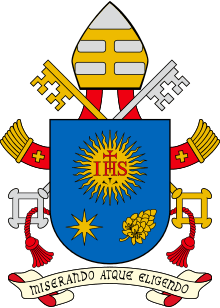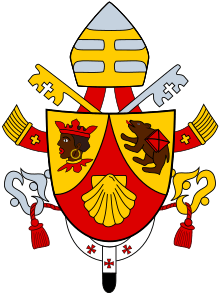St. Gallen Group
The St. Gallen Group, also known as the St. Gallen Mafia, was a group of high ranking, liberal-leaning clerics of the Catholic Church who met discreetly at St. Gallen, Switzerland, between 1995 and 2006 and was founded by Bishop of St. Gallen, Ivo Fürer. The group was revealed to have existed in an officially authorised biography of one of the participants; Cardinal Godfried Danneels; who candidly described the network as a "mafia-club."[1] The group began networking during the later days of the John Paul II Papacy, attempting to stop the ascent of then Cardinal Joseph Ratzinger (later Pope Benedict XVI) as his successor.[2] After failing to turn the 2005 Papal conclave to their desired end, they disbanded, but their views and ideas "paved the way" for the later ascent of Jorge Bergoglio (Pope Francis) in 2013.[2]
Background
Public knowledge about the group came to light in the officially authorised biography of Cardinal Godfried Danneels, the former Archbishop of Mechelen-Brussels; Godfried Danneels Biographie (2015); authored by Jürgen Mettepenningen and Karim Schelkens.[1] At a press conference in September 2015 promoting the book, which was broadcast on Belgian news network, VTM Nieuws, Cardinal Danneels stated that he had been part of a "mafia-club" group called "Sankt Gallen."[1][3][4] This was subsequently reported in the National Catholic Register by Edward Pentin who claimed, “The group wanted a drastic reform of the Church, to make it ‘much more modern’, and for Cardinal Jorge Bergoglio to head it, the group, which also comprised Cardinal Walter Kasper and the late Jesuit Cardinal Carlo Maria Martini, has been documented in Austen Ivereigh’s biography of Pope Francis, The Great Reformer."[5]

Marco Tosatti, an Italian journalist and Vaticanologist, writing in La Stampa, wrote much the same, but also mentioned that the autobiography fingered other members, as well as Danneels, Kasper and Martini, as being St. Gallen Group members, also mentioning Dutch Bishop Ad van Luyn, the German Cardinal Karl Lehmann, the Italian Cardinal Achille Silvestrini and British Cardinal Basil Hume, among others.[6][7] The group which began as a liberal lobby during the later years of the pontificate of Pope John Paul II in 1995 and were opposed to the more conservative Cardinal Joseph Ratzinger, then Prefect of the Congregation for the Doctrine of the Faith, ascending to the Papacy afterward.[7] The aforementioned Cardinals who were still active in 2005, along with fellow St. Gallen Group members Cardinal José Policarpo, British Cardinal Cormac Murphy-O'Connor and Ukrainian Cardinal Lubomyr Husar,[2] attempted to implement their goals at the Papal conclave, 2005, however, Cardinal Ratzinger was elected Pope Benedict XVI and after Martini proved unsuitable, Jorge Bergoglio, an Argentine fellow Jesuit came second. The group disbanded in 2006 and stopped their St. Gallen meetings.
Following the 2005 conclave, the St. Gallen Group had officially wound up their meetings. The highly influential Jesuit, Martini, whom the St. Gallen Group had initially preferred in 2005, died in August 2012. Before his death, he had suggested a reconciliation between Pope Benedict XVI and Cardinal Danneels. According to Jesuit priest, Silvano Fausti, during the Vatileaks scandal in June 2012, Martini had suggested that Benedict retire.[8] The Catholic world was shocked in February 2013, when, for the first time in nearly 600 years, the Pope resigned from his office.
Team Bergoglio
According to Austen Ivereigh, official spokesman for Cardinal Cormac Murphy-O'Connor from 2004-2006, in his The Great Reformer, a gang of four ex-St. Gallen cardinals reorganised as "Team Bergoglio"[9] to advocate the election of Jorge Bergoglio during the 2013 Papal conclave; Cardinals Kasper, Danneels, Lehmann and Murphy-O'Connor.[10][11][12] According to Ivereigh, "They had learned their lesson from 2005 and they first secured Bergoglio’s assent", then "got to work, touring the cardinals dinner to promote their man, arguing that his age should no longer be considered an obstacle, given that Popes could resign."[10] Following the successful election of Bergoglio and the Habemus Papam (beating out competition from Cardinals Angelo Scola and Marc Ouellet), Cardinal Danneels was personally invited by Bergoglio to stand alongside him on the balcony of St. Peter's Basilica, as he was presented as the new Pope.
Un Café con Galat case
The significance of the group has continued to elicit controversy across the Catholic world. For instance in July 2017, in the lead up to a planned Papal visit to Colombia in September 2017, there was a conflict between the Episcopal Conference of Colombia and Teleamiga (a significant Catholic broadcasting company in the country).[13] This was because a show on the network named Un Café con Galat, featuring Professor José Galat, discussed the "Sankt Gallen Mafia"[13] and questioned whether there had been irregularities in the election of Bergoglio, contrary to Universi Dominici gregis. Galat is noted as a champion of conservative Catholic causes in the country and a critic of liberal tendencies in the Church. Monsignor Pedro Mercado of the Ecclesiastical Tribunal of Bogotá declared "For obstinate disobedience toward the pope, José Galat has placed himself outside of the Communion with the Church. He cannot receive the Sacraments."[13]
See also
References
- 1 2 3 "Cardinal Danneels Admits to Being Part of 'Mafia' Club Opposed to Benedict XVI". National Catholic Register. 24 September 2015. Retrieved 24 July 2017.
- 1 2 3 "Cardinal Danneels' Biographers Retract Comments on St. Gallen Group". National Catholic Register. 24 September 2015. Retrieved 24 July 2017.
- ↑ "Danneels: “Zat in soort maffiaclub”". VTM Nieuws. 24 September 2015. Retrieved 24 July 2017.
- ↑ "Cardinal Danneels admits being part of clerical ‘Mafia’ that plotted Francis’ election". LifeSiteNews. 24 September 2015. Retrieved 24 July 2017.
- ↑ "Cardinal Godfried Daneels part of ‘mafia’ club". The Weekend Australian. 24 September 2015. Retrieved 24 July 2017.
- ↑ "Francesco: elezione preparata da anni". La Stampa. 24 September 2015. Retrieved 24 July 2017.
- 1 2 "The Anti-Benedict Conspiracy". The American Conservative. 24 September 2015. Retrieved 24 July 2017.
- ↑ "Martini: Benedict XVI’s resignation and the 2005 Conclave". La Stampa. 18 July 2015. Retrieved 18 July 2015.
- ↑ "What is the truth about Cardinal Murphy-O’Connor and ‘Team Bergoglio’?". The Spectator. 25 November 2014. Retrieved 25 November 2014.
- 1 2 "Author, cardinals spar over reports of conclave campaigning". Catholic News Agency. 4 December 2014. Retrieved 4 December 2014.
- ↑ "Smoking gun? Pope Francis’ critics cite new book in questioning his papacy". The Washington Post. 5 December 2014. Retrieved 5 December 2014.
- ↑ "Pope Francis: how cardinals’ Conclave lobbying campaign paved way for Argentine pontiff". The Daily Telegraph. 22 November 2014. Retrieved 5 December 2014.
- 1 2 3 "Colombian Professor Criticizes Pope Francis, Declared Excommunicated". One Peter Five. 31 July 2017. Retrieved 31 July 2017.


